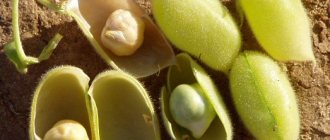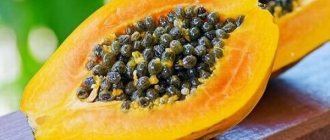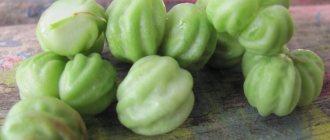What is pomelo and where does it grow?
Pomelo is an evergreen fruit tree, which biologists distinguish as a separate species. This plant belongs to the large genus Citrus of the extensive Rutaceae family. The fruits are named after the fruit tree itself. The plant is also called pompelmus or sheddock. In some sources this citrus is called “pamela”.
The trees bloom and bear fruit 2–4 times a year, which does not affect the weight and quality of the fruit. The harvest is harvested throughout the tropical winter - from December to March.
Strong and flexible tree branches are covered with white flowers of complex structure. The middle part of the flower is elongated and ends with a large greenish pistil, which is surrounded by bright yellow stamens. The small outer petals are curved outward.
In some varieties of citrus, the flowers form lush clusters of inflorescences. After flowering and fertilization, 1–2 fruits are formed in a cluster, the remaining flowers fall off. Other pomelo varieties bloom with single or paired flowers. The diameter of the flowers is 3–7 cm.
The strong branches of fruit trees are covered with hard green leaves. Pomelo leaf blades are similar to laurel leaves, but are several times larger in size.
The tree has a spherical crown and grows in height up to 10–15 m. However, most varieties of pomelo are short-growing. The largest fruits weigh 7–10 kg, and the diameter of the fruit reaches 30 cm.
Pomelo fruits are round, less often pear-shaped. The fruits of all varieties have a characteristic structure. Inside the citrus there are isolated segments separated by partitions. The lobes do not always contain seeds. The taste of the fruit is sweet, sweet and sour with bitterness. The fibers and tissues of the septa are tougher and drier than those of other citrus fruits.
The fruit is covered with a thick peel, and the juicy slices are protected by a thick shell of spongy, porous tissue. This layer is called the mesocarp, or albedo. The thickness of the mesocarp can reach 4–5 cm or more.
The color of the peel and slices depends on the type of crop. Pomelo is grown with yellow, orange and green peel, with red, cream and yellow segments.
Interestingly, only cultivated, domesticated varieties of pomelo are currently known. The wild ancestor of this citrus is not found either in the tropics or in other places on the planet. Biologists have found that pomelo is a hybrid that appeared through accidental cross-pollination of citrus flowers. Perhaps one of the participants in the crossbreeding was an orange. This happened a long time ago, thousands of years ago. Thus, pomelo is mentioned in Chinese written sources dating back to the hundredth year BC.
Where does pomelo grow? The citrus fruit is grown in regions with tropical and subtropical climates. Pomelo is cultivated in gardens and agricultural plantations in Thailand and China, Taiwan and Malaysia, India and Vietnam, Sri Lanka, and southern Japan. There are citrus orchards in which pomelo is grown in Morocco, South Africa, and the United States (California). Pomelo bears fruit well on the islands of Polynesia and Turkey.
Kinds
The genus Citrus includes one species of plant, Pomelo. All known varieties of this fruit tree belong to this species.
According to specialized sources, there are at least 20 varieties of pomelo tree. The most common and popular:
- Khao phuang (Kao fuang).
Produces pear-shaped citrus fruits with a dense, fleshy peel of a yellowish-green color. Yellowish-white or creamy slices are filled with juice with a sour-sweet taste. - Khao paen (Khao paen).
Considered a Thai variety. The fruits are flattened balls with a thick, dense peel of greenish-yellow or salad color. The edible lobes are creamy yellow, pale orange, and juicy. Fruits that go on sale contain undeveloped seeds that ripen during storage. - Khao namphung (Khao namphung).
Produces unusual pear-shaped fruits with bright yellow to greenish-yellow skin. The slices are large, sweet, juicy. The color of the pulp is pastel white or yellowish. - Thongdi (Fongdi or Tongdi).
Grows well in Thailand. The peel of this citrus is thinner than most Asian varieties of this type. The color of the peel is dark green, the surface of the fruit is smooth. The fruits are large (up to 15–17 cm in diameter). The slices are pale pink or watermelon red in color. The taste is sweet. - Khao horn (Khao horn).
Fruit with yellowish-green skin. The slices of this citrus are large and prominent, colored in light yellow tones.
How is a pomelo different from a grapefruit?
These citrus fruits vary in size, appearance and taste, although some varieties of these species are very similar.
Grapefruit is a hybrid of C. Sinensis orange and Shaddock pomelo. Biologists consider cross-pollination of these plants to be accidental. But the result was stable, and the new fruit acquired its own name. This happened in 1750. Since crossing was not initially envisaged, the Welsh monk-naturalist G. Hughes called grapefruit a “forbidden fruit.”
Citrus fruits have several differences.
- The taste of grapefruit always has a sourness characteristic of an orange. There is always bitterness in the fruits.
- The taste of pomelo can be sweet or sweet and sour, with or without bitterness.
- The mesocarp of pomelo is several times thicker than the mesocarp of grapefruit.
- Pomelo slices have much tougher fibers and films than grapefruit.
- Grapefruit peel is orange in color. Pomelo can be deep green, light green, yellowish or gray-orange.
- The color of the fruit segments also differs. Grapefruit has dark red, bright red, burgundy, pinkish-red flesh. In pomelo it is creamy yellow, white, pale yellow and only in some varieties red.
How to choose a ripe pomelo in a store
This citrus fruit is selected using the general rules for purchasing fruits. The pomelo is carefully inspected and the quality assessed. You can buy fruit if:
- The peel is smooth, elastic, and does not contain dark spots, depressions or traces of strong compression.
- The fruit emits a fresh fruity aroma, but not the smell of rot.
- The fruit is evenly colored.
- The stem area remains elastic when pressed, and the finger does not fall inward.
- The peel shows no signs of drying out and the citrus does not seem too light.
- The fruit is elastic and hard; overripe fruit is always soft and may turn out to be bitter.
When buying fruits, pay attention to the negative qualities of the product:
- Severe unevenness in the color of the peel indicates that farmers used too many chemicals and mineral fertilizers.
- You should not buy fruit on the surface of which scars from mechanical injuries are visible.
- Excessive use of nitrates is indicated by burgundy dots on the peel, as well as spots that contrast with the overall color of the fruit.
You should not buy fruit with a sticky surface, this indicates that the product was stored mixed with rotten specimens. Microorganisms could enter a healthy fruit and reduce its quality.
Dishes made from fragrant peel
You can prepare many delicious dishes from the aromatic peel.
So, pomelo peel: use for making jam and candied fruits.
Making jam from sheddock peel
Step #1. To get rid of bitterness, the peel of the giant fruit, cut into cubes, must be soaked in cool water for five days. The water should be changed twice a day.
Step #2. After soaking the crust, add fresh water twice, bring to a boil over low heat, and drain the water. Leave the peel in an open container to cool.
Step No. 3. After cooling, pour syrup made from sugar (750 g) and water (300 ml) over the crusts for 12 hours. Cook the mixture over low heat for 3 days for 20 minutes. A pleasant citrus taste will tell you that the jam is ready.
Making candied pomelo
Follow step #1 from the previous recipe.
Step #1. Pour fresh water over the crusts six times and bring to a boil. Drain the water.
Step #2. Cover the peel with 2 cups of sugar, pour in 200 ml of water, add a pinch of citric acid. Boil for 50 minutes, cool.
Step #3. Place crusts on a baking sheet lined with foil. Dry them in the oven on low heat for at least 4 hours.
How do you eat the treat? It's amazing when enjoyed with herbal tea during the winter cold. The kids will be happy to enjoy delicious candied fruits instead of sweets. Housewives can use fragrant sweets in baking.
How to quickly clean a broom
If you don’t clean the broom, but simply cut it into 4–6 pieces, then a lot of juice will be lost. There are several simple ways to peel fruit. To do this you will need a sharp medium sized kitchen knife. Kitchen experts distinguish between vertical and spiral cleaning methods. Before removing the peel, wash the fruit with cool running water or in any spacious container, changing the water 2 times.
Vertical method
The pomelo is placed on a cutting board or on a table, plate, or tray. The main thing is that the fruit does not slip. Using a knife, cut off the area of the stalk and the opposite part of the peel along with the spongy layer. Make 4 longitudinal cuts through the skin and mesocarp layer. First, a circular incision is made, running like a meridian on a globe. Then another one, perpendicular to the first, then 2 more in the same pattern.
Put the knife aside, take the pomelo, remove segments of the peel and spongy pulp with your hands until edible slices of fruit remain in your hands. Then separate the slices with your hands and remove the films from them.
Spiral method
Cleaning in a spiral is slightly different from the previous method. Cut off the area of the stalk by 1 cm, as well as the area opposite to it. Then the peel and mesocarp are removed by moving the knife in a spiral. Cleaning begins, as in the previous method, from the upper preparatory cut to the lower one. Then the slices are separated and cleaned of films.
Benefits of the king fruit
The benefits of pompelmus for the body are incredibly high. It is recommended to be used for the rapid recovery of the body after protracted illnesses; it is a desirable component in the raw food menu and in the diet of children; it is excellent for weight loss. Pamela helps overcome arrhythmia of the heart muscle, lower cholesterol, improve vision, and prevent disturbances in the gastrointestinal tract.
The beneficial properties of pamela are easily explained, since the delicious yellowish-orange pulp and fragrant peel are a rich storehouse of all kinds of vitamins and minerals, essential oils and fat-dissolving elements. Sheddock contains iron and calcium, phosphorus and sodium, and potassium.
Let's look at what vitamins in pomelo work wonders for the human body. 100 g of pamela contains:
- Ascorbic acid () – 32-52 mg.
The benefits of vitamin C are undeniable for maintaining the immune system, enhancing hematopoietic processes, strengthening the walls of blood vessels, stimulating the functioning of the endocrine glands, and also to fight free radicals.
- Retinol (vitamin A) – up to 30 mg.
It has been scientifically proven that the benefits of vitamin A are manifested in oxidative and reduction processes in the body. It is important for protein synthesis and bone formation, makes hair vibrant and shiny, skin elastic, and prolongs youth.
- B vitamins – up to 0.4 mg.
Vitamins of this group are involved in the production of energy, are responsible for hormonal levels and proper metabolism, and ensure the full functioning of the brain.
How to eat pomelo fruit correctly
Citrus fruit is best eaten fresh, immediately after peeling. Whole slices, cleared of white veins and films, are served on the table. The shares can be cut or divided by hand.
- The fruit is delicious with ice cream, yogurt, fresh and canned cream.
- The taste of pomelo goes well with kiwi, bananas, apples, celery and chocolate.
- The fruit improves the quality of unsweetened salads with shrimp and olives.
- There are many recipes where pomelo pieces are combined with meat and fish. You can safely add pomelo to any salad.
- The juice of the giant citrus is used to make homemade marmalade and jelly.
On a note!
A doctor may allow a diabetic patient to eat pomelo, since the glycemic index of the product is no more than 30 units.
How much can you eat per day
The amount of pomelo per day is not indicated by any serious recommendations. This fruit has recently appeared in stores. When including a product in the menu, you need to focus on the general consumption standards developed for citrus fruits. The amount of product on the table depends on individual health indicators and age, acidity of gastric juice, tendency to heartburn, allergic reactions to fruits, childhood, illness and pregnancy.
A healthy adult can eat 1 pomelo per day if the volume of peeled segments does not exceed the size of an average orange. Children under one year old are not given citrus fruits and juices. The child's digestive system is imperfect, the baby will suffer from pain, gas and discomfort. The child is given citrus juice drop by drop, adding it to drinking water. But it is better to consult a pediatrician. A child can be extremely sensitive to citrus fruits up to 3 years of age.
Children from 3 to 6 years old can include pomelo in their diet, but not more than 3 times a week (give several slices equal in volume to 2-3 small tangerines).
Is it possible to eat at night
A healthy adult can eat pomelo at night, but it is better to do this before 15-16 hours. Vitamins and other beneficial substances contained in citrus fruits are better absorbed in the morning and at lunchtime. If the product is perceived well, you can eat a couple of slices in the evening, but no later than 2 hours before bedtime.
But you can’t get up at night and feast on pomelo. Lying down increases the risk of acid reflux from the stomach into the esophagus, which will lead to severe heartburn.
It is better to eat citrus fruits between breakfast and lunch, after lunch, as these foods often cause discomfort in the intestines. Pomelo is not recommended to be combined with carbonated mineral water. You should not take medications with the juice of this fruit.
Video:
how to clean a broom in one minute Expand
Homemade pomelo tincture
You can prepare pomelo tincture using several recipes, so everyone can choose the best option for themselves. Classic is prepared from the following ingredients:
- 1 kg pomelo;
- 50 grams of granulated sugar;
- moonshine (fruit) – 0.5 l.
Step-by-step execution of the drink, the second name of which is “tincture on pomelo peels”:
- Wash the citrus and, if necessary, pour boiling water over it. Blot dry with a paper towel.
- Separate the pulp from the peel.
- Place the zest on the bottom of the jar and cover with sugar.
- Squeeze out the juice from 1/4 of the pulp.
- Place the remaining pulp and juice in a jar, mix everything and add alcohol.
- Close and leave for a month. Then strain and you can try. The final color and consistency of the finished tincture can be seen in the photo.
If you wish, you can prepare moonshine for pomelo, a recipe with step-by-step photos can be found on the Internet. But the truth requires more time and the presence of a moonshine still.
Why is pomelo bitter?
Bitterness is present in the pulp of all citrus fruits, and pomelo is no exception. The bitterness may be barely noticeable. You can buy fruit that has absolutely no unpleasant aftertaste. But sometimes the pomelo tastes quite bitter.
- The bitterness is caused by the glycoside naringin (neohesperidoside naringenin). In pomelo, this substance is contained in the films and veins that envelop the lobules. If the films and veins are removed, the bitterness will disappear.
- Very overripe fruits are bitter, less so are unripe ones. Fruits of optimal ripeness are almost not bitter.
- Bitterness accumulates in fruits if fruits and foliage have been heavily sprayed with insecticide pesticides.
- If the pomelo was frozen during transportation (or subjected to strong cooling to temperatures close to zero), it will also develop bitterness.
Benefits of pomelo peels
I mentioned in the article, but I will repeat here, that all citrus fruits have useful not only the pulp, but also the rind. It contains vitamin P, which is important for the body. Flavonoids from the vitamin P group in combination with vitamin C, which is also abundant in pomelo peel, have a positive effect on blood vessels, reducing their fragility and permeability.
The benefits of pomelo peels are important for women:
- Vitamin P helps remove excess estrogen from the body
- limonoids, as scientists have found, have shown themselves to be substances that work well to prevent breast cancer and help the female body recover faster after surgery and chemotherapy.










